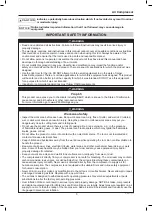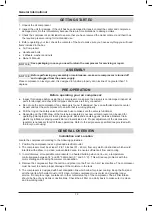
14
General International
4. Connect the air hose to the quick connect socket on the regulator assembly by inserting the quick connect
plug on the air hose into the quick connect socket. The quick connect socket collar will snap forward and
lock the plug into place, providing an air tight seal between the socket and plug. To release the air hose,
push the collar back on the quick connect socket.
5.
Firmly grasp the hose prior to inserting it into the quick connect and when removing it from the quick
connect socket.
6. Plug the power cord into the proper receptacle.
7.
Move the Power Switch to the ON (I) position (pull it up) and the compressor pump will start, building
pressure in the tank until cut-out pressure is reached and the unit shuts off automatically (A).
8.
Adjust the regulator to a psi setting that is needed for your application and be sure it is within the
safety standards required to perform the task. If using a pneumatic tool, the manufacturer should have
recommendations in the manual for that particular tool on operating psi settings.
Drain Valve
●
Make
sure the tank drainage valve (fig.5) is closed and not in the open position.
Pressure Switch
1. Check that the red pressure switch button is pushed down to the OFF position (fig 6)
.
2. Ensure that the power supply you are going to use
is operating normally.
3. Insert the power supply cord into the power supply
socket.
4.
Turn the pressure switch on, pulling the red button
up to the ON position.
5. On the tank pressure gauge fig.2C), you can watch
pressure build in the tank until the pump stops at
the factory-set pressure, about 115 to 125 psi.
6.
This first time running your compressor and
periodically thereafter, check for air leaks. If the
gauge indicates pressure is going down in the tank
or you hear leakage, you could apply soapy water
to all joints in the air transport piping. Tighten these
joints if bubbles form.
fig.5
fig.6






































